Key takeaways:
- Understanding conversion rates reveals actionable insights into business performance, guiding strategic improvements.
- Regularly tracking key metrics like conversion, click-through, and bounce rates uncovers hidden patterns that drive informed decisions.
- Implementing A/B testing enables data-driven adjustments, enhancing elements such as calls to action and user engagement.
- Leveraging customer feedback fosters a connection with the audience and leads to impactful website enhancements.
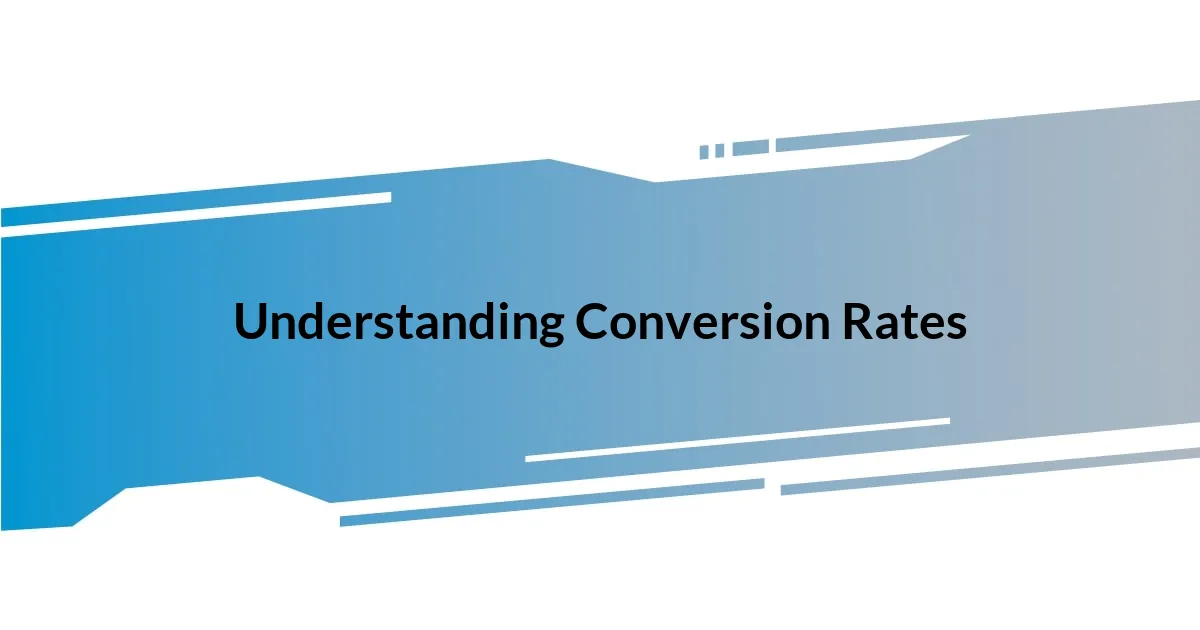
Understanding Conversion Rates
Understanding conversion rates is like holding a mirror to your business strategy; it shows you what’s working and what needs a little TLC. I remember when I first started analyzing my website’s performance. I felt overwhelmed looking at those numbers, yet once I started to grasp what each percentage truly meant, it felt like a light bulb went off.
Conversion rates, at their core, reflect the percentage of visitors who complete a desired action on your site, whether it’s making a purchase or signing up for a newsletter. When I realized that even minor tweaks to my landing pages could double my conversions, it sparked an excitement in me, as if each small change could be a stepping stone toward greater success. Isn’t it fascinating how understanding this single metric can lead to such impactful transformations?
Moreover, the emotional component can’t be overlooked. I’ve felt the disappointment of low conversion rates, which can sometimes make you question your efforts. But I’ve also experienced the joy of seeing those rates climb after implementing strategies grounded in data. It’s a reminder that behind every number, there are real people whose decisions can fuel your business’s growth. The journey of improving conversion rates is a personal one, full of lessons learned and victories celebrated.
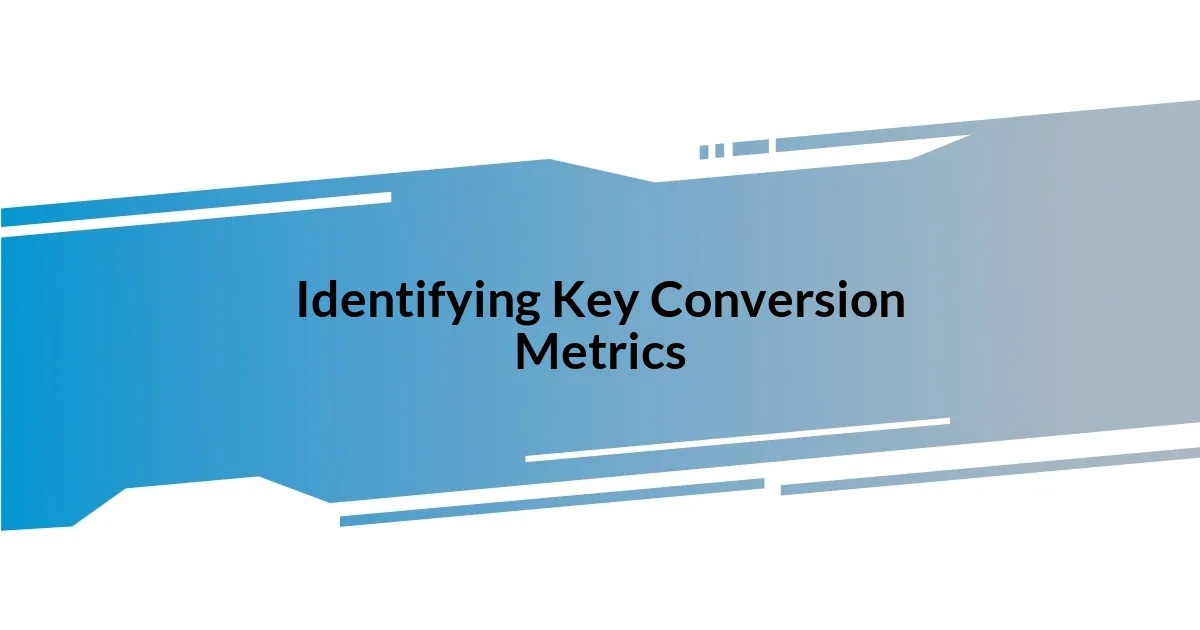
Identifying Key Conversion Metrics
Identifying key conversion metrics is crucial to understanding how well your business is performing. I remember the first time I dove into my analytics and was surprised by how many metrics I was overlooking. Focusing on key metrics like conversion rate, click-through rate, and bounce rate helped me hone in on specific areas needing improvement. Each number tells a story, and uncovering these stories is what truly drives a business forward.
When I began tracking these metrics consistently, I noticed patterns that were initially invisible to me. For instance, my click-through rate on emails was significantly lower than my website’s conversion rate. This insight prompted me to revamp my email marketing strategy, resulting in a notable uptick in conversions. By comparing different metrics side by side, I was able to make informed decisions that led to tangible results.
Creating a clear comparison of these metrics helped me understand their interdependencies better. It was like assembling pieces of a puzzle; once I had them all in place, the bigger picture of my business performance came into focus. Each metric, when analyzed in conjunction with others, revealed insights that guided my strategic choices moving forward.
| Metric | Importance |
|---|---|
| Conversion Rate | Shows the overall effectiveness of your website in turning visitors into customers. |
| Click-Through Rate | Indicates the effectiveness of your marketing campaigns in driving traffic. |
| Bounce Rate | Reflects the percentage of visitors who leave your site without interacting, highlighting engagement issues. |
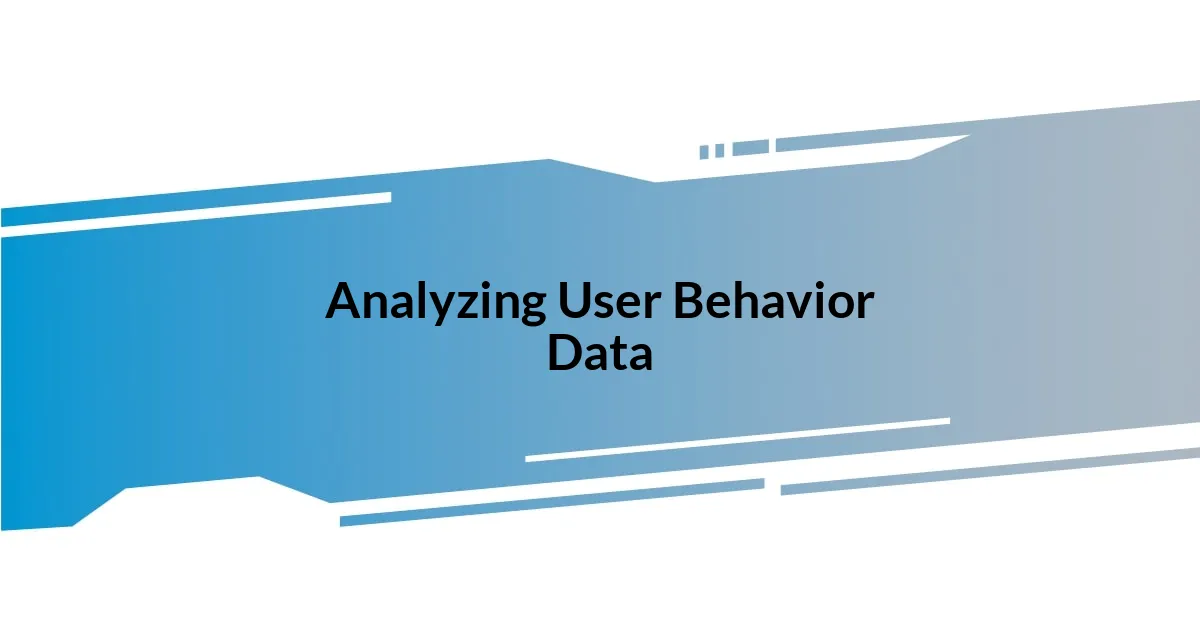
Analyzing User Behavior Data
Analyzing user behavior data is like peering into the soul of your website. I vividly recall the first time I examined my heatmaps; it was both enlightening and a tad disheartening. Seeing where users clicked and where they hesitated revealed unexpected truths. It struck me how many visitors landed on a page but didn’t scroll further. That realization inspired me to rework several pages for better engagement.
A few key insights emerged from digging into the data:
- Click Patterns: Identifying hotspots where users spent the most time guided my layout decisions.
- Navigation Paths: Understanding common user journeys helped me streamline the site experience.
- Time on Page: Analyzing how long users lingered provided clues on content relevance.
Each of these insights became a stepping stone toward refining my site. The emotional highs and lows throughout this journey fueled my determination to create a more user-friendly experience. I still remember the rush I felt when I made adjustments based on this data and saw immediate improvements. It transformed frustration into motivation, propelling my conversion rates higher.
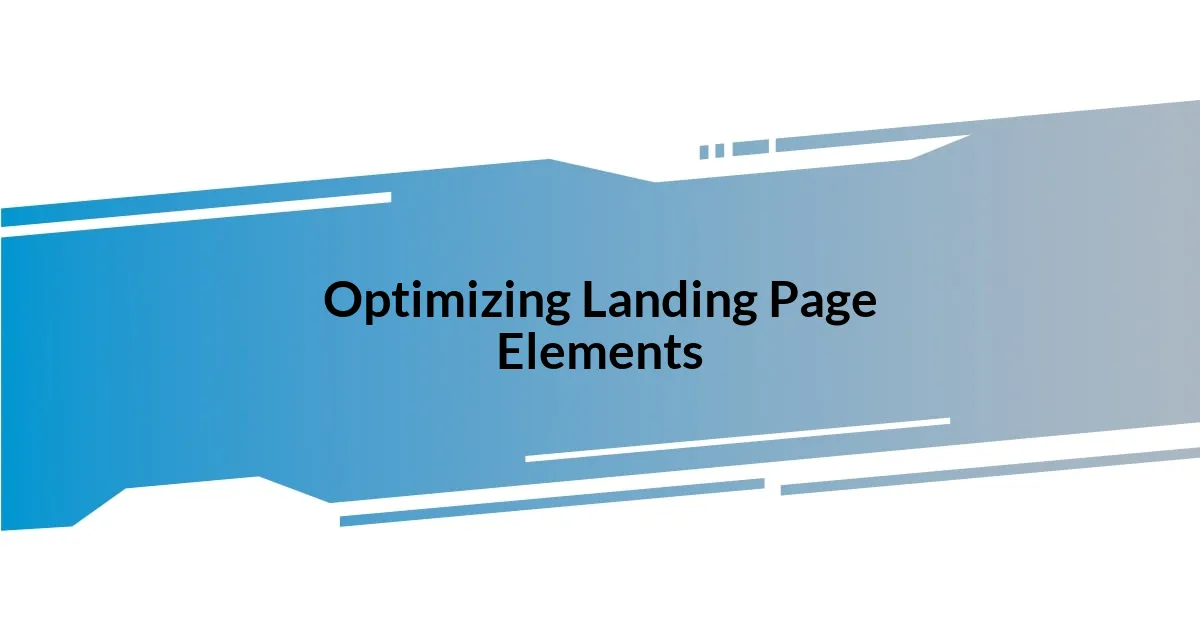
Optimizing Landing Page Elements
Optimizing landing page elements has been a game changer in my conversion journey. For instance, I once had a landing page with cluttered content and multiple calls to action. After gathering feedback and analyzing user interactions, I simplified the layout, keeping the primary message and a single, clear call to action front and center. The difference was astounding. I wondered how I hadn’t made changes sooner; sometimes, less truly is more.
Another factor that proved essential was the importance of visual elements. I recall feeling overwhelmed by analytics that suggested my images weren’t resonating with visitors. By swapping out generic stock photos for authentic images of myself and my team, I created a deeper connection with my audience. People genuinely want to see the faces behind the brand, don’t they? That simple tweak brought a more personal touch and garnered a significant boost in trust and conversions.
Finally, I learned that the emotional tone of my landing pages mattered more than I anticipated. Initially, I wrote in a more formal style, thinking it reflected professionalism. However, I later realized that a conversational tone not only made my content relatable but also encouraged visitors to engage more. Imagine landing on a page that feels like a friendly chat rather than a sales pitch. It transformed my landing pages into welcoming spaces, and I couldn’t be happier with the results that followed.
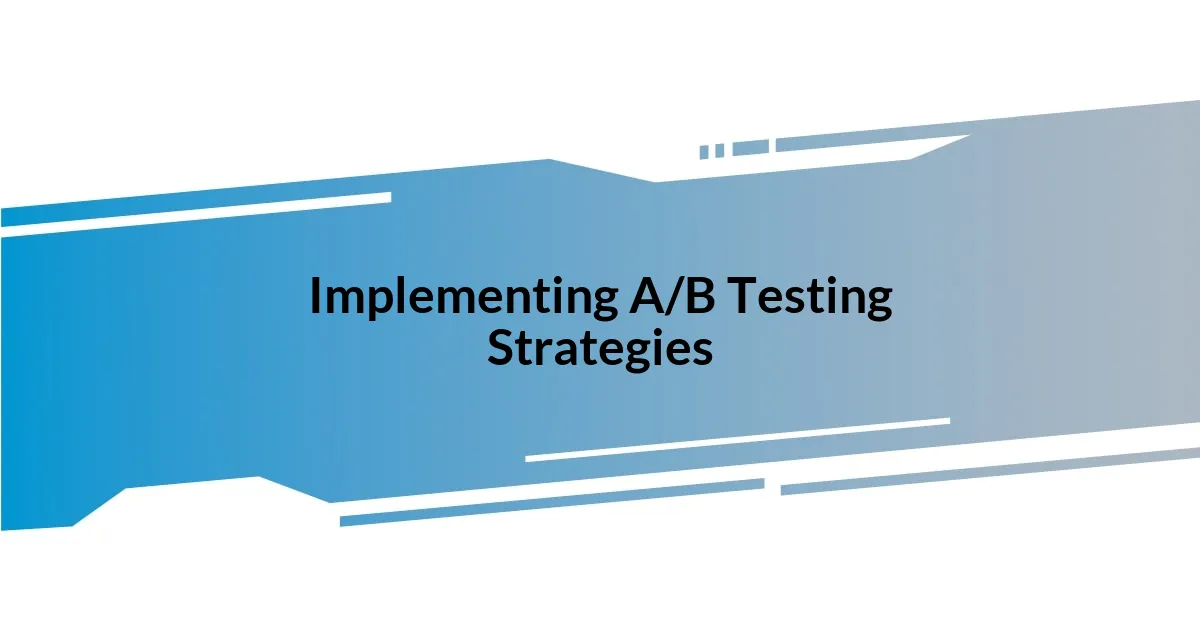
Implementing A/B Testing Strategies
Implementing A/B testing strategies was like discovering a secret toolkit for my website’s performance. I remember my first test vividly: I changed the color of my “Buy Now” button from green to red on one version of the landing page. The results blew me away; the red button not only caught more eyes but also seemed to create a sense of urgency that doubled my click-through rates. Isn’t it fascinating how even small tweaks can result in significant changes?
Diving into A/B testing not only helped me make data-driven decisions but also taught me the importance of patience. I set up tests for various elements—headlines, images, and even the position of my calls to action. Each iteration felt like a mini-experiment. Some changes would flounder, while others soared, and I often found my preconceptions challenged. It was a rollercoaster of emotions—one day I was elated by promising results, and the next I was pondering how an adjustment I thought was brilliant fell flat. Yet, through every setback, I grew more resilient.
One insightful lesson I picked up along the way was to allow enough time for each test to reach statistical significance. Initially, I rushed calls to action based on early data, only to realize that overnight fluctuations didn’t tell the whole story. That sense of urgency led to unnecessary anxiety. By giving my tests the proper duration, I could trust the data more fully. Hasn’t the quest for clarity in decision-making made a world of difference? Embracing A/B testing transformed my approach to marketing, turning what once felt like guessing games into a systematic process of innovation and improvement.
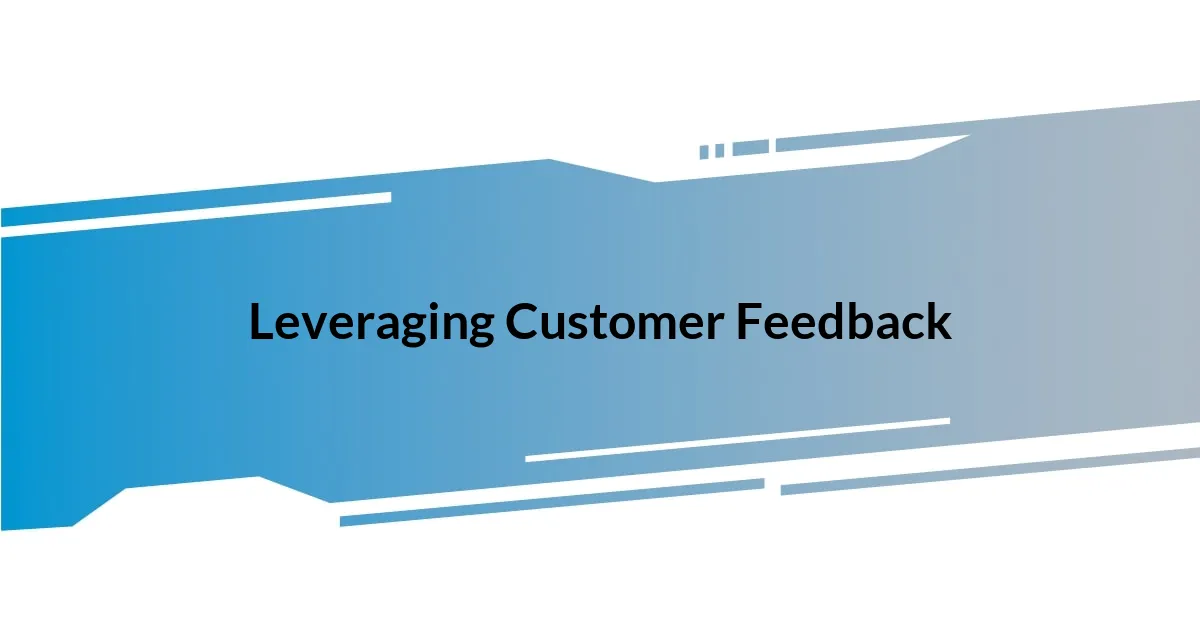
Leveraging Customer Feedback
Gathering customer feedback has been one of my most valuable strategies for improvement. I vividly remember the time I gathered insights through a simple survey sent after purchases. The responses opened my eyes to experiences I hadn’t considered, revealing that customers desired more detailed product descriptions. It made me wonder, how could I have overlooked such a straightforward yet impactful change? By refining my content based on their suggestions, I created a more informative experience that directly resonated with visitors.
One powerful moment came when a long-time customer took the time to share that they found my website navigation confusing. Initially, I felt defensive, but then I realized their perspective was crucial. I decided to put myself in their shoes and embraced their feedback. This led to a complete overhaul of my navigation structure, simplifying it significantly. Imagine the relief of a user finding what they need in just a few clicks! Seeing increased engagement and positive comments afterwards was the sweet validation of being open to criticism.
Additionally, social media gave me a direct line to my audience’s sentiments. I started posting questions and polls, fostering an open dialogue that made visitors feel heard. One day, a follower suggested a new feature, and I thought, could this be the innovation I was missing? After implementing their idea, the positive feedback and increased engagement affirmed that leveraging customer feedback creates a community behind my brand—it’s not just about selling but about genuinely connecting with my audience.
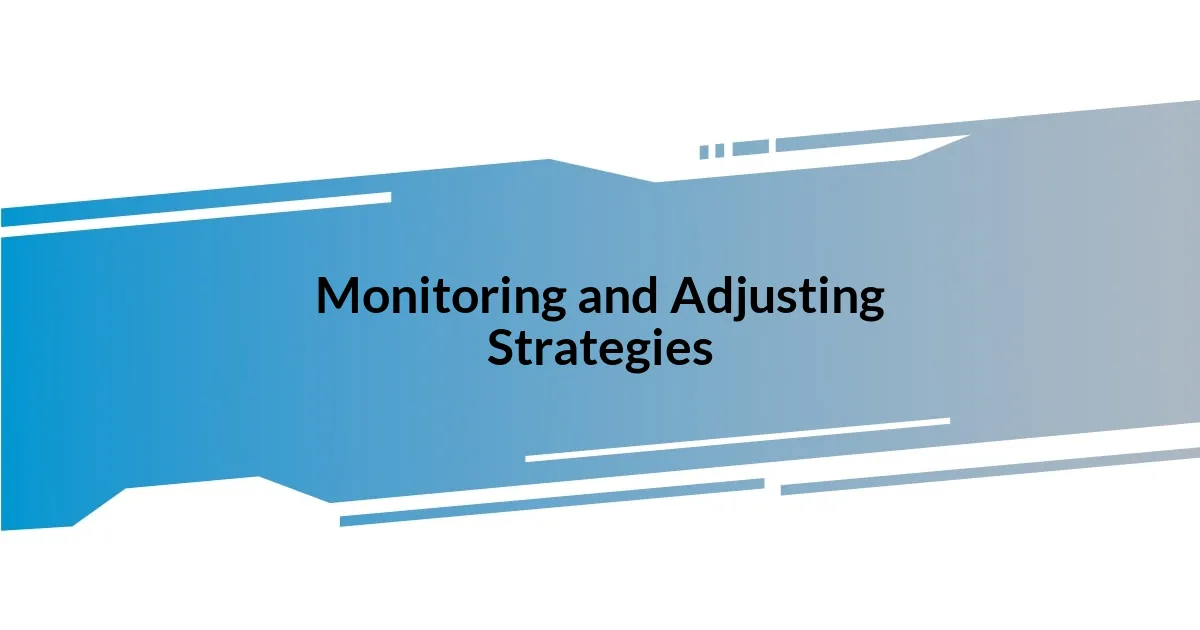
Monitoring and Adjusting Strategies
Monitoring my strategies became a game-changer in how I approached conversion rates. I remember the moment I decided to track user behavior in real-time through analytics tools. It was fascinating to see visitors breeze through my site but leave right before checkout. Why were they bouncing? This realization fueled my determination to dig deeper into the metrics. I started to correlate the data with customer journeys and suddenly, what felt like random numbers transformed into actionable insights.
As I continued to analyze and adjust my approach, I found myself constantly adapting to emerging patterns. There was a point when I noticed a particular landing page wasn’t performing as expected. Even though it looked great on the surface, the bounce rate was telling a different story. After tweaking the messaging and playing around with the layout, I felt a mix of anticipation and doubt. Would this change create a breakthrough or just another roadblock? The relief wash over me when that page finally started converting better; it was a reminder that agility and persistence really pay off.
One critical lesson I learned was the importance of setting clear objectives for each strategy I implemented. As I started to monitor my campaigns more rigorously, I realized that vague goals led to unfocused efforts. Instead, I made sure to define what success looked like: whether it was a percentage increase in click-through rates or a specific number of conversions. It was like having a compass guiding me through the data jungle. Each time I adjusted my strategies based on clear objectives, I could feel the momentum building, confirming that staying nimble was key in this ever-changing landscape.